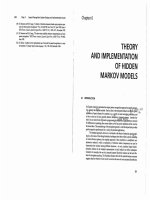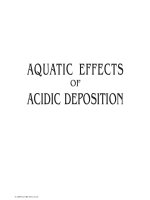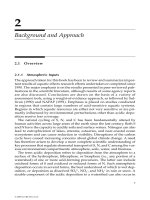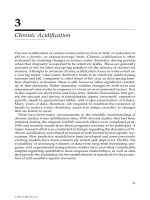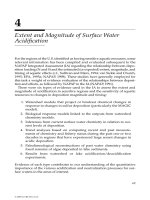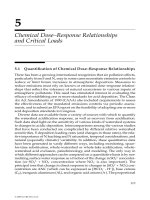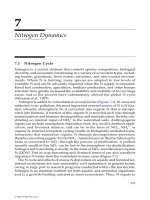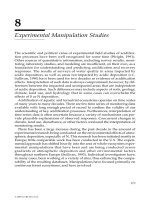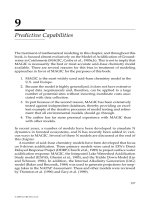AQUATIC EFFECTS OF ACIDIC DEPOSITION - CHAPTER 6 pdf
Bạn đang xem bản rút gọn của tài liệu. Xem và tải ngay bản đầy đủ của tài liệu tại đây (553.33 KB, 15 trang )
139
6
Episodic Acidification
6.1 Background and Characteristics of Sensitive Systems
The acid–base chemistry of surface waters typically exhibits substantial
intra- and inter-annual variability. Seasonal variability in the concentration of
key chemical parameters often varies by more than the amount of acidifica-
tion that might occur in response to acidic deposition. Such variability makes
quantification of acidification and recovery responses difficult, and also com-
plicates attempts to evaluate sensitivity to acidification based solely on index
chemistry. The latter term is applied to chemical characterization data that
correspond with periods when the chemistry is expected to be relatively sta-
ble. These are typically summer or fall for lakes and spring baseflow for
streams. Lakes and streams exhibit short-term episodic decreases in ANC,
and often also pH, usually in response to hydrological events, such as snow-
melt or rainfall. Periods of episodic acidification may last for hours to weeks,
and sometimes result in depletion of ANC to negative values with concurrent
increases in potentially toxic inorganic Al in solution.
Precipitation inputs to a watershed typically pass through the soil profile
prior to reaching stream channels. The typical soil profile in acid-sensitive
watersheds has lowest pH (approximately 4) in upper organic soil horizons,
increasing down the profile to pH greater than 6 at depth (Norton et al., in
press). Drainage water chemistry is generally somewhat reflective of condi-
tions in the lower soil horizons and, therefore, generally has pH greater than
6. During high discharge snowmelt or rainfall events, however, flow routing
favors water flowpaths through upper horizons. During such events, drain-
age water chemistry, therefore, typically reflects the lower pH, higher organic
content, and lower ANC of these upper soil horizons. This is one of the major
reasons why many surface waters are lower in pH and ANC during hydro-
logical episodes.
Many of the same characteristics that predispose aquatic systems to
chronic acidification from acidic deposition (discussed in Chapter 3) also pre-
dispose aquatic systems to episodic acidification. Geology and soils charac-
teristics are important in this regard. However, the single most important
1416/frame/C06 Page 139 Wednesday, February 9, 2000 2:13 PM
© 2000 by CRC Press LLC
140
Aquatic Effects of Acidic Deposition
factor governing the sensitivity of a given watershed to episodic acidification
is hydrology. The pathways followed by snowmelt and stormflow water
through the watershed and into streams or lakes largely determine the extent
of acid neutralization provided by the soils and bedrock in that watershed.
High-elevation watersheds with steep topography, extensive areas of
exposed bedrock, deep snowpack accumulation, and shallow, base-poor soils
are most sensitive. Such systems are common throughout the mountainous
West and in portions of the Northeast and Appalachian Mountains.
Episodes are generally accompanied by changes in at least two or more of
the following chemical parameters: ANC, pH, base cations, SO
4
2-
, NO
3
-
, Al
n
+
,
organic acid anions, and DOC. These changes in chemistry can adversely
impact biota, particularly when changes involve pH, Al
i
, and/or Ca
2+
(Baker
et al., 1990c). Aquatic biota vary greatly in their sensitivity to episodic
decreases in pH and increases in Al
i
in waters having low Ca
2+
concentration,
and it is difficult to classify chemical episodes according to potential biologi-
cal effects. Baker et al. (1990c) concluded, however, that episodes are most
likely to impact biota if the episode occurs in waters with baseline (pre-epi-
sode) pH above 5.5 and minimum pH during the episode of less than 5.0. In
addition, for episodes that occur in systems that are chronically acidic or
nearly so, the increase in acidity during the episode may be biologically sig-
nificant, particularly when it is accompanied by increased concentrations of
Al
i
(Baker et al., 1990c).
Episodic acidification is nearly ubiquitous in drainage waters. Lakes and
streams that have been studied throughout the U.S., Canada, and Europe
nearly all experience loss of ANC during hydrologic events (Wigington et al.,
1990). Chemical changes during episodes are controlled by a number of nat-
ural processes, including dilution of base cation concentrations, nitrification,
flushing of organic acids from terrestrial to aquatic systems, and the neutral
salt effect.* Acidic deposition can also contribute to episodic acidification,
particularly via enhanced NO
3
-
leaching. Under some conditions, episodes
can also be partially caused by increased SO
4
2-
concentration, although S-
driven episodes appear to be less common than N-driven episodes. There is
also the likelihood that chronic acidification by acidic deposition can precon-
dition a watershed, thereby increasing the severity of episodic acidification.
Since preparation of the NAPAP 1990 Integrated Assessment, the EPA has
completed the Episodic Response Project (ERP), an integrated evaluation of
episodic acidification of surface waters during high-discharge periods (e.g.,
storms, snowmelt) in portions of the eastern U.S. (Wigington et al., 1993).
This research provided important confirmatory evidence regarding the
chemical and biological effects of episodic pH depressions in lakes and
streams in parts of this country. The ERP clearly demonstrated that episodic
processes are mostly natural, that SO
4
2-
and, especially, NO
3
-
attributable to
* The neutral salt effect is a process whereby addition of a neutral salt (e.g., NaCl) to base-poor
soils can cause acidification of drainage water that passes through that soil. The mechanism
involves ion exchange between H
+
from the soil ion exchange complex and the neutral salt cation
(e.g., Na
+
) in solution.
1416/frame/C06 Page 140 Wednesday, February 9, 2000 2:13 PM
© 2000 by CRC Press LLC
Episodic Acidification
141
atmospheric deposition play important roles in the episodic acidification of
some surface waters, and that the chemical response that has the greatest
impact on biota is increased Al concentration. Similar findings have been
reported elsewhere, especially in Europe, but the ERP helped to clarify the
extent, causes, and magnitude of episodic acidification in portions of the U.S.
Short-term pulses of increased NO
3
-
concentration have been identified as
the primary factor contributing to episodic depressions of pH and ANC dur-
ing snowmelt in many acid-sensitive Adirondack lakes and streams (Driscoll
and Schafran, 1984; Driscoll et al., 1987a,b; Stoddard, 1994). The magnitude
of episodic acidification is strongly regulated by the base cation, and there-
fore also ANC, concentration in lake waters. High-ANC Adirondack lakes
experience episodes driven primarily by dilution of base cations during
snowmelt, whereas low-ANC lakes often experience episodes driven by NO
3
-
increases (Schaefer et al., 1990). The source of the N released during snow-
melt in Adirondack watersheds includes nitrified snowpack N and also likely
mineralized N from soil organic matter (Schaefer and Driscoll, 1993).
Nitrogen has been experimentally added to a small pristine alpine catch-
ment in Norway at deposition levels similar to those received by some
Adirondack watersheds. Since 1993, 7 kg N/ha per year have been applied
to the Sogndal minicatchment as part of the RAIN and NITREX projects to
augment the ambient loading of 2 kg/ha per year (Wright and Tietema, 1995).
Runoff contained high concentrations of NO
3
-
only during events of high
flow, however, during 9 years of treatment (Wright and Tietema, 1995). These
findings suggest that during low-flow periods, the flow routing of drainage
water and its contact with watershed soils and terrestrial biota allow for effi-
cient utilization of essentially all of the incoming N. In contrast, during high-
flow periods, a portion of the increased N is not utilized, mainly because
drainage water containing relatively high concentrations of NO
3
-
moves too
quickly through the soil reservoir to allow efficient N utilization.
The EPA's National Lake Survey (NLS), conducted in 1984 and 1985, pro-
vided the most comprehensive database on the acid–base chemistry of lake
waters in areas of the U.S. potentially susceptible to the effects of acidic dep-
osition. This synoptic survey was conducted during the autumn index
period, during which time lake-water chemistry typically exhibits low tem-
poral and spatial variability. Although autumn is an ideal time for surveying
lake-water chemistry in terms of minimizing variability, lake-water samples
collected during autumn provide little relevant data on the dynamics or
importance of N in most aquatic systems. Nitrate concentrations in lake
water are elevated during the autumn season only in lakes having water-
sheds that exhibit fairly advanced symptoms of N saturation (e.g., Figure 7.6;
Stoddard, 1994). It is, therefore, not surprising that results of both the Eastern
and Western Lake Surveys, both of which were conducted during the fall sea-
son, suggested that NO
3
-
is of only minor importance compared to SO
4
2-
as an
acid anion in lake waters in this country. For example, the median value of
the ratio of lake water NO
3
-
to (SO
4
2-
+ NO
3
-
) concentration in Florida, the
upper Midwest, and the West were very low and varied from about 0.01 to
1416/frame/C06 Page 141 Wednesday, February 9, 2000 2:13 PM
© 2000 by CRC Press LLC
142
Aquatic Effects of Acidic Deposition
0.06 (Landers et al., 1987; Stoddard, 1994). Survey data with which to evalu-
ate the (largely episodic) effects that might be associated with N deposition
were not collected in these surveys.
Most research on episodic processes has been conducted on stream systems
that are generally more susceptible to such effects than are lakes. Spatial vari-
ability can be considerable in lakes, particularly during snowmelt episodes.
Strong vertical and horizontal gradients in lake-water chemistry often pre-
clude quantification of the magnitude of the effects in lake systems (Gubala
et al., 1991). Because of the logistical difficulties and expense associated with
sampling lake-water chemistry during episodic events in a manner sufficient
to characterize these spatial gradients, few data are available for lakes in the
areas of concern.
A great deal of the research on episodic processes, both before and after
1990, has focused at least in part on the identification of source areas of storm
flow within the watershed. To a large degree, the results of this research have
been less than satisfying. It is clear that water flowpaths are enormously
important in the regulation of drainage water chemistry. It is also clear that
watershed hydrology is complex and varies with different flow regimes. This
complicates the task of attributing chemistry to particular watershed soil
horizons or other source areas. Efforts to “explain” stream-water chemistry
on the basis of soil water chemistry at various points within the watershed
have only been useful in the extent to which the results of such efforts have
communicated to watershed scientists that we do not know everything. In
fact, when it comes to drainage water flow routing in upland catchments, we
seem to know little.
It is very difficult to determine the immediate source of solutes in drainage
water. It is intuitive that the soil water chemistry of the predominant
soil/vegetation types within the watershed should correspond approxi-
mately to the chemistry of drainage waters. In practice, however, this turns
out not to be the case. Data from the Bear Brook watershed manipulation
project in Maine provide a good example. Flow separation calculations using
the ratio of
18
O to
16
O chemical isotopes suggested that the majority of the
stream flow during high discharge events was derived from “old water”
(Kendall et al., 1995), a finding common to most
18
O studies. However, none
of the soil lysimeter sites showed soil water chemistry comparable to stream
chemistry (Norton et al., 1999). The conclusion of Norton and co-workers
was that storm water chemistry at Bear Brook is governed by a mixture of soil
solution and deep groundwater, new water (precipitation and snowmelt),
and micropore water that is not well-sampled by tension lysimeters. The
observed constancy or only slight dilution of base cation concentrations dur-
ing high discharge periods suggested water sources deep within the soil pro-
file, whereas the observed episodic increases in NO
3
-
and DOC
concentrations suggested sources in shallow soil areas. Partly in response to
these recognized uncertainties in the routing of drainage waters within the
watersheds, a hydrologic analysis was conducted for the Bear Brook water-
shed manipulation site by Chen and Beschta (in press).
1416/frame/C06 Page 142 Wednesday, February 9, 2000 2:13 PM
© 2000 by CRC Press LLC
Episodic Acidification
143
To simulate the dynamic hydrological processes at the Bear Brook water-
shed manipulation site, Chen and Beschta (in press) used the Object Water-
shed Link System (OWLS) model of Chen (1996), a physically-based, three-
dimensional distributed watershed hydrologic model. The OWLS model
attempts to represent the major hydrologic processes within the watershed
and also allows dynamic three-dimensional visualization of flow separation
processes and variable source areas. Results of the flow separations sug-
gested that surface flow from riparian areas was the predominant component
of the flood rising limb, whereas macropore flow from riparian areas domi-
nated during the falling limb of the hydrograph. Downstream riparian areas
appeared to be the major contributing areas for peak flow. Because the
18
O
results suggested that most of the high-flow discharge was “old water,” it
must be assumed that deep groundwater in the uplands re-emerges as near-
surface flow in the lower riparian areas. More specific linkages between the
simulated flow routing of drainage water and the observed soil water chem-
istry may further refine our understanding of these complex interactions.
6.2 Causes
Episodic acidification can be caused by several factors, including base cat-
ion dilution and organic acid enrichment, both of which are natural compo-
nents of the hydrological response. Other potentially important factors
include S and N enrichment that can be either natural and/or result from
acidic deposition. The relative importance of these various factors and the
extent to which they contribute to episodic acidification vary by region and
individual watershed.
6.2.1 Natural Processes
The most important cause of episodic acidification of surface waters is base
cation dilution. It is a completely natural process and typically accounts for a
sizable fraction (often more than one-half) of the overall acidification
response during snowmelt or rainfall events. Because hydrological episodes
entail rapid water flow routing through upper soil horizons, base cations are
contributed to drainage waters to a lesser extent than during periods of low
flow. The additional large influx of water in the form of rain or meltwater,
some of which makes only limited contact with watershed soils, further con-
tributes to the observed dilution of base cation concentrations in stream
water during high-flow events.
The altered hydrological flow-routing during episodes that contributes to
lower base cation concentrations in stream water also causes increased con-
centrations of organic acid anions. This is because upper soil horizons tend to
1416/frame/C06 Page 143 Wednesday, February 9, 2000 2:13 PM
© 2000 by CRC Press LLC
144
Aquatic Effects of Acidic Deposition
be relatively rich in organic C. Some of the organic acidity of the upper soils
is transported to streams during high-flow events. The fraction of the epi-
sodic acidification that is caused by organic acid enrichment varies from
watershed to watershed. In some cases, mainly in wetland-influenced high-
DOC streams, the organic acid component of episodic acidification can dom-
inate the episodic response. In other cases, episodic organic acidity is negligi-
ble compared with other components of the episodic response.
For the most part, base cation dilution and organic acid enrichment account
for the ubiquitous nature of episodes. These processes operate with or with-
out acidic deposition and can account for episodic loss of a few
µ
eq/L of
ANC to losses of 50
µ
eq/L or more during snowmelt or rainstorms.
Episodic acidification owing to S or N enrichment can also be a natural pro-
cess in some areas, but both are typically associated with anthropogenic
effects of acidic deposition. In particular, N-driven episodic acidification is
frequently associated with high levels of N deposition.
6.2.2 Anthropogenic Effects
Nitrate in snowmelt runoff has been recognized for some time as an impor-
tant component of biological damage resulting from atmospheric deposition
(c.f., Wigington et al., 1990). Nitrate is the principal acid anion in snowmelt in
many areas of northern Europe and the northeastern U.S. Selective elution of
NO
3
-
from the snowpack can result in early spring runoff having concentra-
tions substantially greater than the average snowpack concentrations. The
biological response to acidic runoff is similar, regardless of whether the pre-
dominant acid anion is NO
3
-
or SO
4
2-
, assuming concentrations of other ions,
including Al
i
, are the same.
Nitrate concentrations in surface waters exhibit a strong seasonality; NO
3
-
is typically elevated during late winter and spring, particularly during peri-
ods of snowmelt, and reduced to low or nondetectable levels throughout
summer and fall. This can be attributed to seasonal growth patterns of forest
vegetation. Vegetation growth is reduced or stopped entirely during winter
months, and microbial assimilation of N is also reduced during this season.
Spring snowmelt can act to flush N into lakes and streams that was deposited
in the snowpack from atmospheric deposition or N mineralized within the
forest floor or soil during winter.
Except in cases of excessive N saturation, the effects of N deposition on
surface waters are expected to be primarily episodic in nature. Unfortu-
nately, data required to make regional assessments of episodic effects are
generally not available. Such data need to be collected on an intensive
schedule and must include sample periods during late winter and early
spring when snowmelt often causes the most severe N-driven episodes of
surface water acidification. Sampling during this time of year is more diffi-
cult and expensive than during the more common summer/fall sampling
seasons. Sampling during snowmelt can be particularly difficult in the high
1416/frame/C06 Page 144 Wednesday, February 9, 2000 2:13 PM
© 2000 by CRC Press LLC
Episodic Acidification
145
mountains of the West, when study sites are often inaccessible, and when
motorized transport (e.g., via snowmobile) is often not allowed owing to
wilderness restrictions.
Aluminum concentration in drainage water is also greatly affected by
hydrological variations. For example, Wigington et al. (1993) sampled 4
Adirondack streams in New York, 3 of which contained maximum concentra-
tions of Al
i
greater than or equal to 485
µ
g/L and maximum weekly average
concentrations of Al
i
greater than or equal to 264
µ
g/L. These are high con-
centrations of Al
i
by any standards, and would be toxic to many species of
fish. Nevertheless, all of these streams had minimum weekly average concen-
trations of 0
µ
g/L and during 25% of the weeks during the course of the year,
the average weekly Al
i
concentration was less than or equal to 94
µ
g/L. In
other words, an assessment of potential Al toxicity conducted during the
times of year when Al concentrations were at their lowest (summer and fall)
would likely conclude that Al was of minor or negligible importance in these
streams. Such an assessment would of course be in sharp contrast to the
extremely high (and toxic) levels of Al
i
achieved during winter and, espe-
cially, spring.
During periods of high discharge, especially during snowmelt, it has been
frequently observed that increasing NO
3
-
concentration contributes greatly to
seasonal or episodic chemistry of streams, and to a lesser extent lakes. The
observed NO
3
-
pulse is often accompanied by a large increase in the concen-
tration of Al
i
. This has led to speculation that NO
3
-
may be a more effective
mobilizer of Al
i
than SO
4
2-
(Driscoll et al., 1991). However, the concentration
of NO
3
-
per se
is not necessarily related to the concentration of Al
i
in surface
waters. For example, Wigington et al. (1993) reported data from three streams
in the Catskill Mountains, NY, that had very similar maximum NO
3
-
concen-
trations (129, 108, 106
µ
eq/L) and maximum weekly average NO
3
-
concentra-
tions (68, 72, 67
µ
eq/L). Despite these similarities in peak NO
3
-
concentrations, however, peak Al
i
concentrations differed by a factor of 4
(159, 72, 505
µ
g/L) and maximum weekly average Al
i
concentrations differed
by a factor of 7 (92, 49, 380
µ
g/L) in these 3 streams. Similarly, the 1 Adiron-
dack stream (Biscuit Brook) sampled by Wigington et al. (1993) that had low
concentrations of Al
i
(75th percentile of weekly average concentration equal
to 20
µ
g/L) had similar NO
3
-
concentrations to the three Adirondack streams
that exhibited much higher concentrations of Al
i
.
The strongly elevated concentrations of Al
i
in drainage waters that are often
observed during winter and spring in general, and snowmelt in particular,
suggest that assessments of acidification effects based on fall index, or synop-
tic survey, data are totally inadequate with respect to evaluating the dynamics
and potential toxicity of Al. The general inadequacy of the hydrological com-
ponent of most acidification assessments is widely acknowledged, and is per-
haps most problematic when considering Al (Sullivan, 1994).
In near coastal environments, the neutral salt effect can have a large influ-
ence on episodic chemistry. For example, mechanisms of episodic acidifica-
tion at Bear Brook watershed in Maine were at least partially controlled by
1416/frame/C06 Page 145 Wednesday, February 9, 2000 2:13 PM
© 2000 by CRC Press LLC
146
Aquatic Effects of Acidic Deposition
the volume and chemistry of the precipitation event, especially the contribu-
tion of ions from seaspray (Kahl et al., 1992; Norton and Kahl, in press). Sim-
ilar results were found at Lake Skjervatjern in western Norway (Gjessing,
1994). It was well-known previously that antecedent soil moisture is an
important determinant of episodic chemical response. It now also seems clear
that, for near-coastal watersheds, the ionic make-up of the rainfall event is
also important.
6.3 Extent and Magnitude
The ERP data for Adirondack streams (Figure 6.1) showed that as stream-
water ANC decreased during hydrological episodes, the relative importance
of NO
3
-
vs. SO
4
2-
acidity increased. In the acidic (ANC
≤
0) samples from the
ERP, NO
3
-
concentrations were often of the same or similar magnitude as
SO
4
2-
concentrations. These are the chemical conditions (high concentrations
of H
+
and Al
i
) that are most toxic to fish. In samples that had positive ANC
values, NO
3
-
was of much less importance relative to SO
4
2-
concentrations
(Figure 6.1), but such conditions are not typically associated with adverse
biological effects (Wigington et al., 1993).
All four of the Adirondack ERP study sites were located in the southwest-
ern highlands area of the Adirondack Park, with maximum elevations of
710 to 775 m. Buck Creek, Bald Mountain Brook, and Seventh Lake Inlet are
typical first- or second-order Adirondack streams. The Buck Creek catch-
ment is characterized by steep terrain with numerous rock ledges and thin
soils. The Seventh Lake Inlet watershed is a combination of moderately
sloping terrain with deeper soils and bedrock outcrops. Bald Mountain
Brook contains a higher percentage of deeper soils (Wigington et al., 1993).
Buck Creek and Seventh Lake Inlet showed similar relationships between
the ratio of NO
3
-
to (SO
4
2-
+ NO
3
-
) concentration and ANC, with increasing
importance of NO
3
-
as a strong acid anion at lower ANC values (
P
< 0.0001,
Figure 6.1). Both had ANC that generally remained below about 20
µ
eq/L.
The watershed with steepest slopes and shallowest soils (Buck Creek) had
the lowest ANC. Bald Mountain Brook and Fly Pond Outlet showed much
wider ranges of ANC values, and ANC was less related to the relative
importance of NO
3
-
as a strong acid anion in these streams. The stream gra-
dient (9m/km) of Fly Pond outlet was the lowest of the 4 Adirondack ERP
study sites. This stream had circumneutral water chemistry and constituted
the reference stream for ERP biological studies in the Adirondacks (Wiging-
ton et al., 1993).
Episodic acidification of streams in Shenandoah and Great Smoky Moun-
tains National Parks has been demonstrated in several recent studies (e.g.,
Hyer et al., 1995; Eshleman et al., 1995; Nodvin et al., 1995; Webb et al., 1995).
Streams with chronic ANC less than about 25
µ
eq/L, in particular, have been
1416/frame/C06 Page 146 Wednesday, February 9, 2000 2:13 PM
© 2000 by CRC Press LLC
Episodic Acidification
147
found to be subject to substantial ANC declines during precipitation events.
Gypsy moth defoliation has also apparently contributed to episodic acidifi-
cation at White Oak Run in Shenandoah National Park owing to increased
NO
3
-
leaching (Eshleman et al., 1995). Mean episodic ANC depressions
increased by about a factor of two after the onset of defoliation.
Webb et al. (1994) developed an approach to calibration of an extreme event
(episodic acidification) model for VTSSS long-term monitoring streams in
western Virginia that was based on the regression method described by
Eshleman (1988). Median, spring quarter ANC concentrations from 1988 to
1993 were used to represent chronic ANC, from which episodic ANC was
predicted. Regression results were very similar for the four lowest ANC
watershed classes, and they were, therefore, combined to yield a single
regression model to predict the minimum measured ANC from the chronic
ANC. Extreme ANC values were about 20% lower than chronic values, based
on the regression equation:
FIGURE 6.1
Ratio of NO
3
-
: (SO
4
2-
+ NO
3
-
) concentration vs. ANC in stream-water samples collected during
hydrological episodes in the four streams included in the Adirondack region of the ERP. Site
identifications: Buck Creek,
•
; Bald Mountain Brook, º; Seventh Lake Inlet,
❏
; Fly Pond Outlet,
∆
. (Source:
Water, Air, Soil Pollut
., Vol. 95, 1997, p. 330, Increasing role of nitrogen in the
acidification of surface waters in the Adirondack Mountains, New York, Sullivan, T.J., J.M. Eilers,
B.J. Cosby, and K.B. Vaché, Figure 8, copyright 1997. Reprinted with kind permission from
Kluwer Academic Publishers.)
1416/frame/C06 Page 147 Wednesday, February 9, 2000 2:13 PM
© 2000 by CRC Press LLC
148
Aquatic Effects of Acidic Deposition
ANC
min
= 0.79ANC
chronic
– 5.88 (
r
2
= 0.97; se of slope = 0.02,
p
≤
0.001)(6.1)
Because the model was based on estimation of the minimum ANC mea-
sured in the quarterly sampling program, it is likely that the true minimum
ANC values were actually somewhat lower than 20% below the measured
chronic ANC. Nevertheless, regression approaches for estimation of the
minimum episodic ANC of surface waters, such as was employed by Webb
et al. (1994) for western Virginia, provide a basis for predicting future epi-
sodic acidification. A model such as MAGIC can be used effectively to
derive estimates of future chronic ANC under various assumptions of
atmospheric deposition. Episodic ANC can then be estimated by applying
the regression approach.
Simple mixing models have also been used successfully elsewhere to sim-
ulate the magnitude of episodic acidification (c.f., Hendershot et al., 1992;
Hooper and Christopherson, 1992; Schaefer and Driscoll, 1993). In the Sierra
Episodes Study (Melack et al., 1998), minimum lake-water ANC was related
to chronic lake-water ANC in a manner that was very similar to that found
by Webb et al. (1994) for Virginia streams. For Sierra Nevada lakes, mini-
mum ANC during snowmelt was about 12% lower than chronic ANC
(Melack et al., 1998).
Episodes of surface water acidification involving increases in NO
3
-
con-
centration have been reported for a few sites in the western U.S. (e.g., Lor-
anger et al., 1986; Loranger and Brakke, 1988; Melack and Stoddard, 1991).
Maximum NO
3
-
concentrations in western lakes and streams reported dur-
ing episodes tend to be low, however, typically less than 15
µ
eq/L (Stod-
dard, 1994). Although such episodic concentrations are quite low in
comparison with many sites in the eastern U.S., increases in NO
3
-
concentra-
tion during episodes at Emerald Lake in the Sierra Nevada have apparently
been sufficiently high, when coupled with natural base cation dilution, to
drive lake-water ANC to zero on at least two occasions (Williams and
Melack, 1991a,b; Stoddard, 1994).
Episodic acidification is an important issue for surface waters throughout
high-elevation areas of the West. A number of factors predispose western sys-
tems to potential episodic effects. There is an abundance of dilute to ultradi-
lute lakes (i.e., those having extremely low concentrations of dissolved
solutes), exhibiting very low concentrations of base cations, and therefore
ANC, throughout the year. Large snowpack accumulations occur at the high
elevation sites, thus causing substantial episodic acidification via the natural
process of base cation dilution. Many of the high-elevation drainage lakes
exhibit short hydraulic retention times, thus enabling snowmelt to rapidly
flush lake basins with highly dilute meltwater. The hydrology, physical char-
acteristics (e.g., bedrock geology, lake morphometry), and climate through-
out high elevation areas of the West provide justification for considering
potential episodic acidification to be an important concern. In addition, the
few studies that have been conducted to date confirm the general sensitivity
of western lakes to episodic processes.
1416/frame/C06 Page 148 Wednesday, February 9, 2000 2:13 PM
© 2000 by CRC Press LLC
Episodic Acidification
149
Lakes and streams in the Sierra Nevada, Cascade, and Rocky Mountains
are highly sensitive to potential acidic deposition effects because of the pre-
dominance of granitic bedrock, thin acidic soils, large amounts of precipita-
tion, coniferous vegetation, and extremely dilute waters. There are no data to
suggest, however, that lakes in these areas have experienced chronic acidifi-
cation to ANC values less than zero to date, and based on examination of cur-
rent chemistry, it appears that chronic acidification has not occurred to any
significant degree. It is possible, however, that episodic effects are occurring
under current deposition regimes, and that NO
3
-
concentrations have caused
a small loss of ANC on a chronic basis at some high-elevation sites. Unfortu-
nately, the data that would be needed for such determinations have not been
collected to a sufficient degree in acid-sensitive areas of the West to permit
any regional assessment of either episodic or chronic N-driven acidification.
In the Rocky Mountain region, Loch Vale has been the subject of intensive
research on hydrochemical responses to snowmelt. Loch Vale is located in
Rocky Mountain National Park, CO, at an elevation of 3000 to 4000 m. The
watershed is comprised primarily (81%) of exposed bedrock and talus (Baron
and Bricker, 1987). The snowmelt is characterized by three general periods:
1. Flushing of concentrated lake water out of the lake during early
snowmelt, and release of the winter's accumulated atmospheric dep-
osition from the snowpack. The minimum lake-water pH (approxi-
mately 5.7) and highest NO
3
-
concentrations occur at this time.
2. Dilution phase during which ionic concentrations in lake water are
diluted by the continuing melt.
3. Decreasing hydrologic flows, yielding very dilute lake water during
the summer months (Baron and Bricker, 1987; Wigington et al., 1990).
High concentrations of NO
3
-
and SO
4
2-
in the early phases of snowmelt have
also been documented for other high-elevation sites in Colorado (Reddy and
Caine, 1988) and Wyoming (Clow et al., 1988).
Vertucci and Corn (in press) collected weekly water samples during the
snowmelt season at three sites in the Front Range, CO, ranging in elevation
from 2800 to 3050 m. They also examined data from sites in the Elk Moun-
tains, CO, and West Glacier Lake, WY. Snowmelt adjacent to West Glacier
Lake was acidic (ANC = -20
µ
eq/L), although water sampled from the lake
outlet maintained ANC greater than 0 on nearly all sampling occasions. Pat-
terns of ANC at the Elk Mountain site were related to changes in base cation
concentrations owing to dilution. Vertucci and Corn (in press) found no evi-
dence of chronic acidic conditions at any of the three Front Range sites, and
minimum ANC values were associated with low base cation concentrations,
rather than elevated acid anion concentrations.
In the North Cascade Mountains, Loranger and Brakke (1988) observed a
50% decline in the ANC of Bagley Lake to a low of 67
µ
eq/L following snow-
melt. Because the anion concentrations were so low in the snowpack, most of
1416/frame/C06 Page 149 Wednesday, February 9, 2000 2:13 PM
© 2000 by CRC Press LLC
150
Aquatic Effects of Acidic Deposition
the ANC loss was attributed to dilution of base cations by meltwater. The
annual average ANC of Bagley Lake was 100
µ
eq/L. From August through
October, the ANC in the lake increased by nearly 30
µ
eq/L. The shallow
depth of the lake promoted rapid mixing and flushing (short residence time).
Thus, most of the NO
3
-
in the snowpack passed through Bagley Lake (eleva-
tion 1800 m) during the period of most rapid snowmelt; by mid-June NO
3
-
concentrations in the lake had decreased from over 5
µ
eq/L to less than 2
µeq/L. Loranger and Brakke (1988) concluded that NO
3
-
and SO
4
2-
concentra-
tions in the snowpack were too low to result in significant pH depression
during snowmelt. In contrast, Eilers et al. (1994b) observed virtually no
change in ANC in a small lake in the southern Cascade Mountains, OR, dur-
ing snowmelt. Lake Notasha, a seepage lake in southern Oregon also situated
at 1800 m, varied only a few microequivalents from an average ANC of 10
µeq/L. Despite its extremely low base cation concentrations (approximately
20 µeq/L; Eilers et al., 1990), the lack of surface inlets to Lake Notasha results
in a long hydraulic residence time (5 to 10 years) which provides a buffer
against even substantial increases in acidic inputs. Because of high anion
retention, seepage lakes in the southern Cascades such as Lake Notasha are
likely far less sensitive to potential increases in acidic deposition than lakes
with similar C
B
elsewhere in the West.
In contrast to lakes in the southern Cascades, lakes in the Sierra Nevada
receive both greater acidic deposition and higher rates of runoff. In the Emer-
ald Lake watershed (elevation 2800 to 3416 m), NO
3
-
increases of about 120%
have been observed in the streams during snowmelt (Melack and Stoddard,
1991; Williams and Melack, 1991b). Concentrations of NO
3
-
in the Emerald
Lake outlet increased from 2 to 3 µeq/L in the fall to 10 to 13 µeq/L during
spring runoff. The increase in NO
3
-
and SO
4
2-
(approximately 50%) was attrib-
uted to preferential elution from the snowpack and low retention rates in the
watershed. Reduction of NO
3
-
and SO
4
2-
within Emerald Lake was relatively
small, and most of the acid anions passed through the lake outlet. This increase
of both SO
4
2-
and NO
3
-
during snowmelt in Emerald Lake in the Sierra Nevada
contrasts with observations in the Adirondacks where snowmelt runoff
diluted SO
4
2-
as well as base cation concentrations (Schaefer et al., 1990).
Melack et al. (1993) reported two years of intensive research at seven high-
elevation lakes in the Sierra Nevada. The lake elevations varied from 2475 to
3425 m, and the catchments spanned the length of the high-elevation Sierra
Nevada. Solute concentrations, particularly ANC and base cation concentra-
tions, were greatest during winter, declined to minima during snowmelt, and
gradually increased during summer and autumn. Sulfate concentrations var-
ied most in lakes with lowest volumes, and were generally less than 10 µeq/L
in 5 of the 7 lakes. In Speuller and Topaz lakes, however, SO
4
2-
concentrations
generally ranged from 10 to 30 µeq/L, and from 30 to 60 µeq/L, respectively.
These were the 2 shallowest lakes (mean depth 1.6 and 1.5 m) and were rela-
tively high in elevation (3121 and 3219 m). Nitrate concentrations were gen-
erally low in all lakes (less than 4 µeq/L), although NO
3
-
concentrations
increased during snowmelt in most lakes owing to inputs of stream water
1416/frame/C06 Page 150 Wednesday, February 9, 2000 2:13 PM
© 2000 by CRC Press LLC
Episodic Acidification 151
enriched with NO
3
-
. In the first few days of snowmelt, the concentration of
NO
3
-
in High Lake increased by a larger amount than did the concentration
of base cations, causing ANC to decline to values below zero (Stoddard,
1995). Zooplankton species known to be intolerant of acidification were
found in all seven lakes, and Melack et al. (1993) concluded that their pres-
ence is evidence that Sierra Nevada lakes are not currently showing chronic
biological effects of acidic deposition.
6.4 Biological Impacts
The ERP (Wigington et al., 1993) included chemical and toxicological analy-
ses of 13 streams in the northeastern U.S. during multiple seasons. In situ bio-
assays were conducted for brook trout, sculpins, and blacknose dace. At all
of the streams, some bioassays resulted in low mortality (less than 10%), illus-
trating that toxic conditions do not occur at all times in a given stream
throughout the year. Chemical conditions toxic to fish occurred at some time
during the year in all of the ERP study streams, except the reference streams
that were comparatively stable in their chemistry and generally had pH
greater than 5.5. A key finding of the ERP study was that the single most
important variable for predicting episodic fish mortality was the episodic
concentration of Al
i
. Of lesser importance, but also significant predictors of
mortality, were Ca
2+
, pH, and DOC. Furthermore, although fish exposed to
high Al
i
for longer periods of time had higher mortality, the time-weighted
median Al
i
concentration usually provided as good or better predictions of
fish mortality than did more complex expressions of integrated chemical
exposure (Wigington et al., 1993).
Episodic Response Project results clearly demonstrated that episodic acid-
ification can have long-term adverse effects on fish populations. Streams with
suitable chemistry during low flow, but low pH and high Al levels during
high flow, had substantially lower numbers and biomass of brook trout than
were found in nonacidic streams. Streams having acidic episodes showed
significant mortality of fish. Some brook trout avoided exposure to stressful
chemical conditions during episodes by moving downstream or into areas
with higher pH and lower Al. This movement of brook trout only partially
mitigated the adverse effects of episodic acidification, however, and was not
sufficient to sustain fish biomass or species composition at levels that would
be expected in the absence of acidic episodes. These findings suggested that
stream assessments based solely on chemical measurements during low flow
conditions will not accurately predict the status of fish populations and com-
munities in small mountain streams (Baker et al., 1990c; Baker et al., 1996;
Wigington et al., 1996).
The Shenandoah National Park Fish in Sensitive Habitats Project (FISH) is
an ongoing effort to assess fish community responses to stream acidification
1416/frame/C06 Page 151 Wednesday, February 9, 2000 2:13 PM
© 2000 by CRC Press LLC
152 Aquatic Effects of Acidic Deposition
in Shenandoah National Park, VA (Bulger et al., 1995). The aim is to assess
potential impacts and to predict likely future effects based on current rela-
tionships between water chemistry and fish population responses. The study
design includes high-frequency measurement of stream discharge and water
chemistry (especially episodic chemistry) in three streams, fish community
and habitat surveys, and bioassays with brook trout and blacknose dace.
Additional streams are surveyed less intensively to address issues of spatial
variability. Results of the FISH project will provide a wealth of biological
response data, and will greatly improve our predictive capabilities in the area
of biological effects of acidification. The results of the episodic aspects of this
project will be prepared for publication in the near future (Art Bulger, Uni-
versity of Virginia, personal communication.).
The potential role of acid deposition in the observed recent declines in
amphibian populations has been the subject of several recent studies in the
western U.S. For example, the boreal toad (Bufo boreas) has experienced recent
widespread decline throughout the southern Rocky Mountains since about
1975 (Corn et al., 1989; Carey, 1993). Leopard frogs (Rana pipiens) have also
declined in Colorado and Wyoming (Corn et al., 1989). Harte and Hoffman
(1989) hypothesized that episodic acidification was the principal cause of the
decline of at least one amphibian species in Colorado, the tiger salamander
(Ambystoma tigrinum). If episodic acidification is an important factor with
respect to amphibian decline in the Rocky Mountains, then two conditions
must be met: episodic acidification to toxic levels (of pH, Al, etc.) must occur,
and sensitive life stages of the amphibian species must also be present at the
time of the episodic acidification. Contrary to the situation in eastern North
America, where spring and summer rainstorms are the dominant hydrologi-
cal events that influence the chemistry of amphibian breeding habitats, epi-
sodic acidification events in the Rocky Mountains occur primarily during
early snowmelt in the spring. The life history strategies of most amphibian
species make them unlikely to be exposed to acidification during snowmelt
(Corn and Vertucci, 1992; Vertucci and Corn, 1996). Direct mortality of Bufo
boreas embryos from exposure to low pH is unlikely because most snowmelt
and associated pH depression occurs prior to egg deposition (Vertucci and
Corn, 1996). In addition, Rana pipiens generally occupy lakes at lower eleva-
tions that tend to be insensitive to episodic acidification (Corn and Vertucci,
1992). Vertucci and Corn (1996) concluded that there is no evidence that epi-
sodic acidification has led to acidic conditions in the Rocky Mountains or that
sensitive amphibian embryos are present during the initial phases of snow-
melt when episodic acidification might occur.
Quite different conclusions were reached by Kiesecker (1991) and Turk
and Campbell (1997). In the area around Dumat Lake, just south of the Mt.
Zirkel Wilderness Area in Colorado, 60 to 70% of tiger salamander eggs
were dead or unviable in ponds at about pH 5.0 or less, about 40% in ponds
at pH between 5.0 and 6.0, and about 20% at about pH 6.0 or greater
(Kiesecker, 1991). Turk and Campbell (1997) used bulk snowpack acidity
data from Buffalo Pass, adjacent to the Mt. Zirkel Wilderness Area, and
1416/frame/C06 Page 152 Wednesday, February 9, 2000 2:13 PM
© 2000 by CRC Press LLC
Episodic Acidification 153
measured amplification factors from an acid pulse during snowmelt at
Loch Vale in Rocky Mountain National Park to predict the acidity of melt-
water at Buffalo Pass. Their estimates of snowmelt acidity were high (e.g.,
pH less than 5.0) for a large portion of the snowmelt. It is important to note,
however, that the greatest concentration of acidity in snowpack within the
Rocky Mountains appears to occur in and near the Mt. Zirkel Wilderness
Area (Turk and Campbell, 1997) where this study was conducted.
In the Sierra Nevada, no relationship was found linking current deposition
chemistry and the status of amphibian populations (Bradford et al., 1992;
Soiseth, 1992). We have insufficient data at this time with which to fully eval-
uate the role of episodic acidification as a causal factor in amphibian decline.
Episodic acidification probably plays a role in the areas with the most acidic
snowpacks, but it is unlikely to be regionally important throughout the high-
elevation areas of the West. The extent to which acidic snowmelt influences
the pH of amphibian breeding habitat in Rocky Mountain National Park and
other Class I areas in Colorado remains uncertain. We would not expect
many locations to exhibit such high levels of acidity pulses as were estimated
by Turk and Campbell (1997) for Buffalo Pass simply because the bulk snow-
pack at most locations seems to be higher in pH (Peterson and Sullivan,
1998). In the absence of more detailed surveys of the chemistry of known or
suspected amphibian breeding habitat within potentially sensitive areas, it is
not possible to draw any firm conclusions at this time regarding potential
effects on amphibians.
1416/frame/C06 Page 153 Wednesday, February 9, 2000 2:13 PM
© 2000 by CRC Press LLC
